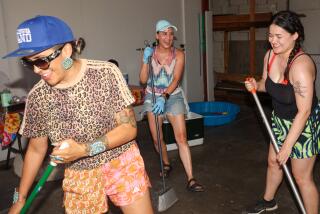Severed Ties : County Closes Office for Relations With Minority Communities
- Share via
Bryan BrightCloud of Granada Hills was watching the mail for his copy of the monthly American Indian newsletter. He got some bad news instead: a letter explaining that the county can no longer afford to publish it.
“I don’t know what we’ll do,” said BrightCloud, president of a nonprofit corporation that collects food and clothing for distribution to poor Native Americans. His notices in the American Indian Calendar of Events reliably prompted readers to send him checks along with the names of people in need.
“It’s the only way Indian people stay in touch,” he said. “This is really a bad deal.” The calendar had filled a demand created when Talking Leaf, a Los Angeles newspaper for Native Americans, folded in the mid-1980s.
The calendar had been assembled, reproduced and mailed to 2,000 households for the last eight years by Colleen J. Colson, the American Indian liaison in the county Health Services Department’s office of community relations.
But the $413,139-per-year office, which also served the county’s black and Asian communities--was closed Friday. Colson, two other community liaisons and a staff support employee are being transferred to other jobs under a cost-cutting plan endorsed by county supervisors.
“That unit costs in the neighborhood of half a million dollars,” said Mary O. Jung, deputy director of the department. “But when faced with [a choice of] that or keeping a health center open, we [decided to] keep the health center open.”
The liaisons, whose job had been to stay in close contact with community leaders and report directly to department Director Robert Gates, predicted that the county’s decision will prove costly in the long run.
Asian American liaison Miya Iwataki said that in seven years on the job she had helped the county government make significant strides in cultural sensitivity. At first, she discovered that county employees were distributing flyers incorrectly translated into a Chinese dialect that urged people to use “paper bags” rather than “condoms.”
Now, Iwataki said, there is a formal review process to screen materials before they are distributed to members of 10 different Asian ethnic groups.
“Our communities have their own [distinct public health] needs,” Colson said. For instance, she said, Native Americans suffer higher than average alcoholism problems.
Similarly, African American liaison Gloria Gray noted that blacks suffer an inordinately high infant mortality rate. And Asians are notoriously heavy smokers, Iwataki said.
“[When] I’m gone, nobody will speak for my community,” Colson said.
That assertion was disputed by Jung. “We are getting input from people who are already in the field” at 29 county clinics, she said. For example, Jung said, “We have health educators out there [in the San Gabriel Valley]. They are telling us that Asians are heavy smokers and we need to target our [anti-smoking] campaign to the Asians and the youthful Asian smokers as well.”
The public campaigns are directed by the department’s health education coordinator, Abel Martinez, who supervises a nine-member staff that provides learning activities for schools and community groups.
But the liaisons say they offered an extra level of service.
“I’ll get a call at home at 9 or 10 at night from a mother who said her boy has been shot and he’s in the emergency room at” Martin Luther King Jr./Drew Medical Center or County-USC Medical Center, Gray said. “I’ll go out there and be with them all night long and make sure their loved ones are getting the proper services.”
More to Read
Sign up for Essential California
The most important California stories and recommendations in your inbox every morning.
You may occasionally receive promotional content from the Los Angeles Times.










